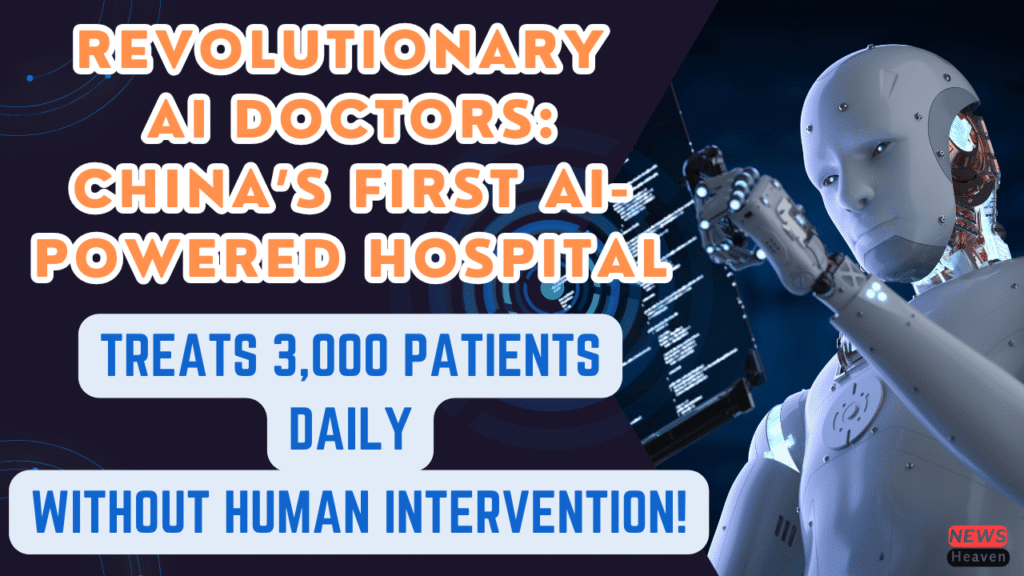China has launched the world’s first AI-powered hospital, where intelligent robot doctors treat up to 3,000 patients daily without human intervention. Discover how AI is transforming healthcare with precise diagnoses, prescriptions, and 24/7 accessibility.

The Future of Healthcare: AI Doctors Working at China’s First AI-Powered Hospital
China has opened the world’s first AI-powered hospital, where smart robot physicians are taking care of patients without any human help. This is a big step in changing the way healthcare works. This cutting-edge hospital can treat up to 3,000 patients a day. It uses cutting-edge artificial intelligence to diagnose, prescribe, and keep an eye on recovery with unmatched speed and accuracy.
This hospital is a big step forward in using AI in healthcare as we enter a time where AI will drive innovation. These robots use natural language processing (NLP) and medical knowledge databases to do things that humans just can’t do as well. AI doctors are changing the way we think about healthcare delivery, from the first visit to regular check-ups during recuperation.
1. Cutting-Edge Natural Language Processing (NLP)
In China’s hospitals, robots powered by AI use advanced natural language processing to talk to patients in real time. They can interpret and respond to patient questions, turn symptoms into medical diagnoses, and make treatment recommendations, which almost completely removes the chance of human error. This technology lets patients quickly voice their concerns and have them dealt with.
2. They have easy access to medical knowledge databases.
These robots are always getting new information from huge medical databases that contain the most recent research, treatment plans, and case studies. They can make decisions based on the most accurate, up-to-date data because they can access it now. These robots don’t have to rely on their memories like human doctors do; they always have access to a giant database of medical knowledge.
3. 24/7 Accessibility and Scalability
AI doctors are always accessible to treat patients, day or night, unlike human doctors who require time to relax, take breaks, and recover. This implies that patients can get care whenever they need it, which cuts down on wait periods and lets the hospital handle more patients at once. AI-powered hospitals can help areas with limited access to healthcare address medical emergencies right away and on a large scale.
4. Being accurate in diagnosing and treating
AI-powered robots have diagnostic algorithms that help them find trends in medical data. This lets them find even the smallest signs of illness and make more accurate diagnoses than people can. AI robots can also make individualized treatment plans, prescribe medications, and keep an eye on recovery after a diagnosis, all without the need for human supervision.
5. Affordable and easy to get to
One of the best things about AI doctors is that they can lower the cost of providing healthcare. Hiring doctors, nurses, and other medical staff can be costly due to their training and leave requirements. AI physicians, on the other hand, don’t cost much to run and can treat many patients quickly and effectively. This efficiency could make healthcare cheaper and easier to get for people all over the world, especially in underserved areas.
The Pros and Cons of AI Doctors
Pros:
- Faster healthcare: AI doctors can immediately diagnose and treat patients, significantly reducing wait times.
- AI hospitals can treat thousands of patients, even in places where there isn’t much healthcare infrastructure.
- No Human Error: AI systems are made to be very accurate and not get tired or make mistakes like human doctors do.
- Cost-Effective: AI makes healthcare cheaper by lowering the price of hiring people.
Cons:
- Loss of Human Touch: AI can speed up things, but patients may miss the personal touch that a regular doctor gives them.
- Dependence on technology: Relying too much on AI could lead to issues in situations where human judgment is crucial, such as in very complicated or unusual medical cases.
- Data Privacy: Using a lot of patient data makes people worry about privacy and security.
What’s Next for AI in Healthcare?
As hospitals and healthcare systems that use AI continue to flourish, we are entering a time where robots and algorithms will be more and more important in medical care. AI might help with procedures, keep an eye on patients from afar, and even make medicine more individualized by looking at each person’s genetic and health data.
China’s AI-powered hospital gives us a glance into what healthcare might be like around the world in the next several decades. We might see more hospitals run by AI, but it’s doubtful that all human doctors would go away. AI will work with doctors and nurses to improve their skills and give them support. This will make the healthcare system around the world more efficient, economical, and accessible.
In conclusion, AI doctors are here to stay.
China’s AI-powered hospital is the first of its kind in the world, and it shows how AI can change healthcare in a big way. AI physicians are not only speeding up and making healthcare more efficient, but they are also making it more scalable and available to people all over the world by automating diagnoses, medications, and recovery monitoring. It’s apparent that AI will play a bigger role in healthcare as it continues to improve. This opens up new possibilities for the future of medicine.
Also read: YouTube’s New Monetization Rules: A Shift Towards Authentic Content

Pingback: UPI 2.0 Alert: 5 Game-Changing Rules You Must Know (Effective August 1, 2025)